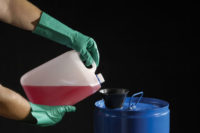
Multiple, and often conflicting, factors enter into the selection of hand protection. In most industrial settings, each job must be thoroughly evaluated by industrial hygienists, safety officers or individual employees to determine the very best hand protection match.
No one glove protects against every hazard while offering the desired properties — dexterity, grip, comfort, etc. — for accomplishing every task. Hand protection selection is a matter of balancing desired properties with the level of protection needed. With hundreds of glove styles available, it is essential to understand how different glove attributes come into play.
The following eight questions are designed to help in glove selection.
Factor #1: Does the glove fit?
First and foremost, the glove must fit. To determine proper fit, measure the circumference of the hand around the palm or at the base of the metacarpals. The number of inches will help determine the correct size:<7 inches = Extra Small
7.5 inches = Small
8 inches = Medium
9 inches = Large
10 inches = Extra Large
> 10.5 inches = Extra Extra Large
Factor #2: Does the glove offer the necessary dexterity?
Dexterity is one of the most desirable properties in any glove. Some jobs require more dexterity than others. The most desirable gloves feel as if you are not wearing gloves at all.In general, disposable thin-gauge gloves made from elastomeric polymers such as natural rubber latex (NRL), nitrile or neoprene or even plastic PVC offer the greatest dexterity and tactile sensitivity. A disposable glove that is 4 to 8 mils thick provides touch sensitivity for the finest motor manipulation of small parts, laboratory work, patient contact or food preparation. As gloves get thicker, dexterity is traded off in order to gain durability or protection.
Factor #3: Will the glove be used in the healthcare environment or as protection against biological contaminants?
Disposable gloves provide excellent protection from viral and bacterial agents that may be present in body fluids:â- Medical grade exam gloves are the best choice for bloodborne pathogenic microorganisms.
â- Medical grade disposable gloves have a tighter acceptable quality level (AQL) for freedom from pinholes than their industrial-grade counterparts.
â- Some disposable latex, nitrile and neoprene gloves have extensive test data proving their viral barrier efficacy such as certification to NFPA 1999 Standard for Emergency Medical Services. Such certification means that the gloves have passed ASTM viral penetration testing under the auspices of an independent, third-party certification organization.
Factor #4: Does the worker need protection against chemicals?
Some disposable nitrile gloves offer excellent protection from oils and greases and limited splash protection from some chemicals. NRL gloves are not resistant to organic chemicals, and especially not to petroleum-based chemicals. Nitrile, on the other hand, offers limited protection from many organic chemicals, especially petroleum-based aliphatic hydrocarbons and fuels.In the laboratory, nitrile gloves offer very good protection from exposure to dry chemicals and most other laboratory chemicals. They offer even more protection when they are layered. Disposable nitrile gloves would be inappropriate for use in heavy contact total immersion in a heavy industrial environment. There is no disposable glove that works well with acetone, one of the most widely used solvents in chemical laboratories.
Factor #5: How tough does the glove need to be?
Because of their durability and low cost, cotton and leather gloves are often used in environments where multiple tasks are performed and where abrasive materials or heavy objects are handled. Polymer-coated work gloves invariably involve a textile substrate (cotton, nylon, Kevlar® or Dyneema®) and coatings made from NRL, PVC, nitrile, neoprene or polyurethane. The resulting coated gloves have been shown to outwear cotton and leather by 10 to 20 times.The longest-wearing gloves also have the thickest coatings and, therefore, the least dexterity. To get both excellent dexterity and very long wear, consider gloves with lighter weight coatings or even palm-coated or flat-dipped gloves. Newer models offer a three-quarter dip that provides knuckle protection with maximum flexibility.
Factor #6: Does the worker need cut resistance?
The rating system from ANSI standard 105-2005 American National Standard for Hand Protection Selection Criteria is based on ASTM testing for cut resistance. Cut-resistant gloves are ranked from level 0 to level 5, worst to best, based on the weight needed to cut through the materials: Level 0 = <200 grams to Level 5 = > 3,500 grams. The higher the level, the more force applied to a sharp object the glove can withstand.There is, however, no glove that offers protection from a circulating or serrated blade. Engineering controls must be relied upon for protection from such motorized hazards.
Factor #7: Will the worker be handling oily, slippery objects?
Holding onto oil-coated objects can be troublesome. Newer sponge, or foam-coated, gloves provide the ability to hold onto oily objects without slippage. These coatings were developed with a greater coefficient of friction to ensure better gripping ability. Oil penetrates the gloves making them better able to grasp the object, whereas other coatings repel oil, making them slippery.Factor #8: Are there chemical hazards on the job?
Janitorial and sanitation chemical hazard: When choosing gloves for the aqueous chemicals used in janitorial/sanitation operations, a number of gloves work well, including those coated with NRL, nitrile, neoprene and PVC.Automotive chemical hazard: For chemicals used in the automotive industry such as oils, greases and fuels, nitrile is the best overall choice. In fact, one of the main other uses for nitrile is for automotive hoses and parts because nitrile is not broken down by these types of chemicals. Conversely, NRL gloves are particularly prone to severe degradation in and around oils, greases and fuels. Neoprene offers very good protection, and PVC gloves are used in numerous refining operations because of their extremely long-wearing properties and low cost.
Solvents, acids and bases chemical hazard: The selection process is much more difficult for protection from solvents, acids and bases. Chemical databases provided by glove manufacturers provide advice for safe glove selection. Sometimes you can make a generalization based on the chemical class such as:
â- Butyl or laminate gloves work best for ketones.
â- Nitrile works best for aliphatic hydrocarbons or fuels.
â- Viton or laminate gloves work best for halogenated hydrocarbons or aromatic hydrocarbons.
â- Neoprene works best for most acids and caustics.
However, there are exceptions to these rules. Again, check glove manufacturers’ chemical databases.
In general, chemical-resistant gloves that do not have a textile substrate offer greater dexterity and touch sensitivity than textile-lined, polymer-coated chemical-resistant gloves.
Hand protection philosophy
Choosing the right hand protection for each job is critical. For employees, knowing they are protected and have a safe working environment can be a major catalyst for improved work performance, job satisfaction and positive morale to the benefit of the entire workplace environment.
Sidebar: Selection Criteria for hand protection
1. Fit2. Dexterity
3. Use in healthcare environment or to protect against biological contaminants?
4. Is chemical protection needed?
5. Toughness
6. Cut resistance
7. Are oily, slippery objects being handled?
8. Are chemical hazards involved?
